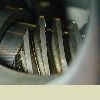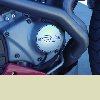| Author |
Message |
    
Blake
| | Posted on Friday, December 31, 2004 - 06:47 pm: | 





|
Steve,
I walked right by the IMechE headquarters building in London a few years back. Very cool. I was kinda like hallowed ground for a fellow BSME.
I agree the term "engineer" has become diluted. It seems many fancy themselves an "engineer" without truly appreciating what that title really means and the level of responsibility it conveys. Much of the general public just go happily about their lives taking for granted the products of dedicated expert engineers everywhere. What fries my brain even more are the jerks who see fit to badmouth and belittle engineers. Show me someone who does that and I'll show you someone who is likely incompetent at their own job.
Rant off. 
Happy New Year! |
    
Jprovo

| | Posted on Friday, December 31, 2004 - 07:19 pm: | 





|
BSME 1999, EIT 1999
Working in the RV industry, I am one of two in the 20+ person "engineering" department with a degree in engineering, the other person being the Engineering Manager. Most people in this industry are not degreed, especially when most things are built from experience, tested, and then documented (Reverse Engineered). Luckily, my peers respect my degree and look to me for guidance in future design.
James |
    
Steveshakeshaft
| | Posted on Saturday, January 01, 2005 - 07:16 am: | 





|
IMechE, Birdcage Walk, London. Pity you didn't take a look inside. All old leather and dark wood panelling, oil paintings of the true victorian masters of engineering as an art form as well as a science etc etc.... hallowed ground indeed. All the very best to BadWebbers the world over for a happy and indeed safe 2005. Be sure anyone, to look us up when you visit the UK.
Steve
www.ukbeg.com
steve_s@ukbeg.com |
    
M2nc
| | Posted on Saturday, January 01, 2005 - 10:57 am: | 





|
Country, I would want a PE to stamp a drawing for a bridge that is going to carry my tail across it, but there are many other forms of engineering that a PE is not required. In our engineering department many are two-year tech graduates. They set up machines to manufacture parts. In the past, I designed and stamped drawings for special options to our products, no PE. My wife's step-father worked and retired from P&G as an Engineer. He designed the electrical requirements for new plants. He two had a two-year technical degree. I see your point that the term "engineer" is mis-used. Sanitation Engineer, need I say more. But until the English language is change to differientiate between a designer, a layout tech and a professional engineer, I will continue to represent myself as being an Engineer. |
    
Lornce

| | Posted on Saturday, January 01, 2005 - 02:58 pm: | 





|
"Hey, don't knock engineers. If it wasn't for those guys and their goofy notions, we'd all be out'a work." - One Millwright to another.

Lornce |
    
Blake
| | Posted on Saturday, January 01, 2005 - 08:18 pm: | 





|
Carlos,
With what did you "stamp drawings"? 
Anyone can sign off on drawings internal to a corporation. The onus is upon the corporation to ensure the integrity of their product. Try and build a public bridge, any public/civil structure, roadway, foundation, electrical works, dams, etc without the stamp of a PE and or Architect as applicable. Ain't gonna happen.
When you say "stamp" that implies licensed professional approval.
Representing oneself professionally as an engineer without having the applicable professional license is simply dishonest and is illegal in every state I know.
Telling new acquaintances in answer to their casual question of "what do you do" that one is an engineer is certainly not illegal.I used to do the same myself. But I now see it as not quite 100% honest and diminishing of the title, achievements and efforts of those who truly are licensed professional engineers. |
    
Mbsween

| | Posted on Saturday, January 01, 2005 - 08:21 pm: | 





|
Hey Blake,
do you know if you have to retake the EIT exam after a period of time? |
    
Blake
| | Posted on Saturday, January 01, 2005 - 09:53 pm: | 





|
In Texas the FE is good for around 8 years I think, but you can ask for a waiver if you go over that time before taking/passing the PPE. Not sure what the criteria for granting waivers is. |
    
Vegasbueller

| | Posted on Saturday, January 01, 2005 - 10:28 pm: | 





|
"Hey, don't knock engineers. If it wasn't for those guys and their goofy notions, we'd all be out'a work." - One Millwright to another.
But Lornce... how many times have you ever said: "Why in the heil did the engineer do that"?
  |
    
Craigster
| | Posted on Saturday, January 01, 2005 - 11:18 pm: | 





|
HR Professionals in (semi-conductor anyway)use the terminology of:
Assembler = builds product
Mechanic = builds installs and repairs product
Technician = fixes engineers mistakes and makes them actually work
Designer = (used to be draftsman) makes pretty 3D images of product as well as telling the Engineer what GDT is over and over again
'X' Engineer = (place Mech, Elec., software, Process etc. in the X) Gets hung for any and all delays in design and test of prototypes. Usually given a budjet of $16.00 and one week to develop something that should take 8 months and $900,000
Sr. Engineer = Been doing Engineering long enough to to know better and is usually looking for a new job
Seriously - When a company advertises for Mechanical Engineer - I'd bet fewer than 5% are PEs. Like you say Blake, it's not illegal - but I think it's also understood and accepted; If you have your degree and it's on your card - you're an engineer. If your're a PE, you can and should take credit for it.
My sister has her PhD. She's not a an MD - Does that mean we shouldn't call her doctor even if she has her doctorate?
Now that I think about it - I guess what I'm thinking is that if one is employed as an engineer - they would be an engineer. I've known several folks who have left industry to do other things and now no longer call themselves engineers, (and rightly so).
If one is a Professional Engineer they should take credit for it.
I have one patent, and several applied for. But I'm not a PE. Does that mean I didn't engineer a new solution to an existing problem? The patent would seem to argue that.
As Kevin cameron wrote: many motorcyclists spend nights in the garage 'fixing' what the factory did wrong. When motorcyclists do more than just hack a new bracket or bolt on a shiny part - When they actually look at a scenario and explore the evidence and attack the problem perhaps with some experimentation involved - and develop a new design to solve our problem - are those men not engineering? Thus they must be engineers.
please excuse the typos - my son is in my lap and has helped strike keys quite a bit during this post |
    
Lornce

| | Posted on Saturday, January 01, 2005 - 11:50 pm: | 





|
But Lornce... how many times have you ever said: "Why in the heil did the engineer do that"?
Vegas, I used to say that but now just proceed straight to: "If it wasn't for those guys and their goofy notions, we'd all be out'a work."

I've seen some pretty funny engineering oversights over the years. Of course human nature tends more to remember the oversights than the brilliant successes.
My hat's off to them, either way.  |
    
Whodom

| | Posted on Sunday, January 02, 2005 - 08:31 pm: | 





|
Mbsween,
In SC, there used to not be a time limit on the EIT. Not sure whether that's still true or not. I took and passed the EIT in my senior year (1978) and didn't take the PE until about 1997. Passed both on the first try.
The requirements are on line; I'm sure you can find out with a little effort.
Hugh |
    
Rek

| | Posted on Sunday, January 02, 2005 - 08:43 pm: | 





|
As an ironworker I ran into an interesting engineering oversite while whorking on a dam in NM. The bottom six feet of a spillway we were building called for #11 rebar to be spaced on 2" centers. Since #11 rebar is 1.25" in diameter it was (is) physically impossible to accomplish this. The really horrible part is the general-foreman of the job insisted that we drive these 40' long sticks of #11 rebar into the wall until he heard otherwise. (read freak'n moron). It was a agonizing two days before the spec's were changed.
Rob |
    
Shawn_9r

| | Posted on Sunday, January 02, 2005 - 09:44 pm: | 





|
ok... catching the tail end of this thread and too lazy to read back. Are you guys saying that just because you have a degree for some where that makes you and "Engineer"? I have deployed to Afghanistan and Iraq and it never seems to fail that I run into some "Electrical Engineer" who does not know his Buttocks from a Hole in the ground. They never want to take into consideration ampacity of cable, fucntionablity and placement of transformers. Now I don't have a degree(yet) but have installed/operated and maintained power plants and designed distribution systems 4160VAC and a distribution system for 11,000 VAC for the Army. All meeting OSHA and NEC standards and all that other HAZMAT stuff.
I guess what I am trying to say is... just because I don't have a degree(yet) does that mean I am not an Engineer? Or better yet... just because a guy attended school but has no practical experience and does have a degree (and don't know caca)does that make him "An Engineer"?
Thanks for letting me rant,
Shawn
"Army Engineers"
Essayons! |
    
Blake
| | Posted on Sunday, January 02, 2005 - 11:27 pm: | 





|
just because I don't have a degree(yet) does that mean I am not an Engineer?
In most cases, yes. "Technician" or "designer" would usually be a better description in your case.
just because a guy attended school but has no practical experience and does have a degree (and don't know caca)does that make him "An Engineer"?
I don't know anyone with an engineering degree who doesn't "know caca"; I know some that are what I would consider lacking in technical depth of knowledge.
The answer to your question though is "absolutely not."
Rob,
That sounds like a simple typo type of mistake that should have been caught by a drawing checker. That said, engineers are human beings like everyone else and sometimes they make mistakes. BTW, #11 rebar should be 1.410" in diameter. Up to #8, rebar # is designated in 1/8 inch increments of "nominal" diameter with #8 then being 8/8"=1.000". For some reason of which I am ignorant, above #108 the rebar diameter is slightly larger than the preceding 1/8" numbering convention and thus instead of 11/8"=1.375" for #11 we have 1.410". 
Also that type of mistake is very strange since the minimum allowable spacing of parallel strands of rebar is the greater of 1" or one diameter of free space between bars (two diameters center to center). For #11 rebar, the absolute minumum spacing any engineer or designer should ever consider is set by code to no less than 2.82" center-to-center.
As project manager if such an egregious mistake made its way onto final construction drawings, I would darn near be forced to issue a stop work pending comprehensive review of all essential structural/construction drawings, and you can bet the engineer of record would have some serious splaining to do.
Rebar spacing is also limited to a minimum of no closer than
Here's a pretty comprehensive checklist that will give you an idea of what a structural engineer must consider before putting his seal upon any drawing... |
    
Blake
| | Posted on Sunday, January 02, 2005 - 11:32 pm: | 





|
quote:
References
ICBO, 1994, Uniform Building Code, Structural Engineering
Provisions, International Conference of Building Officials,
Whittier California
ICBO, 1997, Uniform Building Code, Structural Engineering
Provisions, International Conference of Building Officials,
Whittier California
ICBO, 1994, 1994 UBC Structural CheckList, International Conference
of Building Officials, Whittier California
DPIC, 1988, Lessons In Professional Liability, Design Professionals
Insurance Company, Monterey, California
CHECKLISTS FOR THE QUALITY ASSURANCE OF CALCULATIONS, DESIGN AND
DRAWING PRODUCTION
CALCULATIONS, ANALYSIS, AND CODE
Verify the that the following items have been addressed and are
included in the calculations and Code checks:
Gravity Loading
Review and compare initial dead load assumptions with
the weights of the members chosen for final design
Are Dead Loads overly conservative, i.e. very
heavy such that wind uplift and lateral overturning
are not safe, use .85 dead load or less to resist
overturning
Dead load slope correction factors
100 psf at all exits, corridors, common areas
HVAC Loading, RTU's, suspended equipment, tanks
20 psf partition loading (UBC 94 pg 2-3)
[UBC 97 pg 2-2]
Live load reduction (UBC 94 pg 2-4)
[UBC 97 pg 2-3]
Unbalanced loading combinations
Deflection, ponding, vibration perceptibility
Hydrostatic uplift
Load Combinations (UBC 94 pg 2-2)
[UBC 97 pg 2-4]
All combinations included (preliminary design vs final)
1.33 stress increase for combinations with wind and
seismic (UBC 94 pg 2-2) [UBC 97 pg 2-5]
IF 1.33 stress increase is applied to load combos as .75,
then don't also apply 1.33 to stresses
Do not apply that .75 to deflection calculations
Clearly clarify which calculations use Working
Stress/ASD vs LRFD/ULT
Snow Loading (UBC 94 Appendix 16 pg 2-1199)
[UBC 97 pg 2-387]
Snow drift at parapets, equipment, screen walls, low
roofs, snow (Pg vs Pf), rain on snow surcharge (UBC
94 pg 2-1203) [UBC 97 pg 2-389]
Wind Loading (UBC 94 pg 2-8)
[UBC 97 pg 2-7]
Exposure, Enclosed/partially open
Wind speed: note fastest mile or 3 second gust
Pressures on walls and roof are all applied
simultaneously?
1.5 factor of safety for overturning (2/3 dead load
resisting moment), except for short, squat buildings
(UBC 94 pg 2-9) [UBC 97 pg 2-7]
Net uplift: Is assumed Dead Load appropriate for
resisting wind uplift and overturning?
Uplift forces, H clips at wood trusses, brace
bottom/compression flange of beams
Wind drift < .0025 h
Quartering wind, corner columns
Real plan torsion (UBC 94 pg 2-2)
[UBC 97 pg 2-1]
Elements and Components if < 1000 sf (UBC 94 pg
2-33) [UBC 97 pg 2-29]
5 psf interior partition loading (UBC 94 pg 2-6)
[UBC 97 pg 2-3]
Seismic Loading
Irregular structure, plan or vertical (UBC 94 pg 2-14)
[UBC 97 pg 2-12]
Simplified static procedure limitations [UBC 97 pg 2-12]
Dynamic analysis trigger (UBC 94 pg 2-14)
[UBC 97 pg 2-12]
Near-source factor [UBC 97 pg 2-11, 2-35]
Base Shear (UBC 94 pg 2-16) [UBC 97 pg 2-14]
97 UBC redundancy, overstrength factors
[UBC 97 pg 2-13]
Seismic weight:
25% of storage live load in seismic weight, (combine
Seismic lateral load with 100% of vertical live
load + dead load)
10 psf partition seismic weight to floors
(UBC 94 pg 2-16) [UBC 97 pg 2-13]
Snow load if > 30 psf
Operating weight of equipment in seismic weight
Ballpark check: Period T approximately = 0.1 x Number
of stories
Ballpark check:: For S=1.5, regular building, Ct =
0.020, T=Ct(hn)^.75; the following relationships
hold true:
C=2.75 when T < .56 sec
C=2.75 when hn < 85' (approx. 6 stories)
(UBC 94 pg 2-16)
Rw, R with height limits (UBC 94 pg 2-37)
[UBC 97 pg 2-32]
Rw, R combined along different/same axes, use lower
value (UBC 94 pg 2-18) [UBC 97 pg 2-15]
Vertical distribution of force formula (UBC 94 pg 2-18)
[UBC 97 pg 2-15]
5% accidental torsion included (UBC 94 pg 2-18)
[UBC 97 pg 2-15]
Column strength (3 Rw/8) load combinations for
irregular structures (UBC 94 pg 2-19)
[UBC 97 pg 2-16]
Calculated drift < .04/Rw & .005h ("Calculated" drift
does not include 3 Rw/8 factor) (UBC 94 pg 2-20)
[UBC 97 pg 2-16]
3 Rw/8 x deflection, pounding
Deformation Compatibility (UBC 94 pg 2-24)
Building Separations (UBC 94 pg 2-26)
Use 1.7 allowable stress increase for "strength"
calculations, but do not include 1.33 stress increase.
Coordinate with .75 factor in load combinations
Delta s vs Delta m [UBC 97 pg 2-16]
P delta (UBC 94 pg 2-20) [UBC 97 pg 2-14]
Vertical component of seismic, effects greater than 1.33
gravity?
Seismic Forces on Parts of Structure
Rigid equipment, > 400 lbs (UBC 94 pg 2-22)
[UBC 97 pg 2-18]
2/3 Fp if supported on ground (UBC 94 pg 2-22)
[UBC 97 pg 2-18 formula (32-2)]
If tank with toxic substances, Ip=1.50
(UBC 94 pg 2-35) [UBC 97 pg 2-30]
Seismic Detailed System Requirements
0.85 DL for uplift load combinations (UBC 94 pg 2-23)
[UBC 97 pg 2-19, 2-4]
Corner columns, orthogonal effects, SRSS combine
(UBC 94 pg 2-24) [UBC 97 pg 2-19]
3 Rw/8 x deflection, pounding
Deformation Compatibility (UBC 94 pg 2-24)
[UBC 97 pg 2-19]
Building Separations (UBC 94 pg 2-26)
[UBC 97 pg 2-21]
Use 1.7 allowable stress increase for "strength"
calculations, but do not include 1.33 stress increase.
Coordinate with .75 factor in load combinations
Delta s vs Delta m [UBC 97 pg 2-16]
Cladding connections (UBC 94 2-24) [UBC 97 pg 2-19]
Ties
Collectors
Anchor walls, 200 plf min (UBC 94 2-25 and 2-6)
280 plf [UBC 97 pg 2-20, 2-3]
Diaphragms: Deflection
Force equation (31-1) (UBC 94 pg 2-25)
[UBC 97 pg 2-20 eqn (33-1)]
Rw =6 if flexible diaphragm with heavy walls
Continuous crossties
No cross grain bending or nail withdrawal
If plan irregular, then no 1 1/3 stress increase for
diaphragms and collectors
Projecting wing motion out of phase
Building Separations (UBC 94 pg 2-26)
[UBC 97 pg 2-21]
Nonbuilding Structures (UBC 94 pg 2-26)
[UBC 97 pg 2-21] and Table 16-P (UBC 94 pg 2-39)
[UBC 97 pg 2-34]
Rigid structures eqn (32-1) (UBC 94 pg 2-27)
[UBC 97 pg 2-21 eqn (34-1)]
Tanks
Global Load Path
Load Path: continuous and in proportion to relative
rigidities of elements
Gravity: From roof to foundation, connections
Seismic: From each mass and/or level to foundation,
connections
Wind: From walls and roof to foundation, connections
Stability
Global
Local
Sloping members, sloping bearing surfaces: forces
accounted for?
Computer Analysis
Units consistent, ft, in, kips, degrees vs radians
Member orientation correct? Weak vs strong axis bending.
Global vs local loading direction
Positive y loading is up or down, self weight loading is
down
Check plot of model for configuration, load and reaction
direction, case by case
AISC unbraced lengths may be greater than the default
length of node to node; k, Cm, Cb defaults, x, y
directions
Global Restraints: Are global restraints appropriate? If
a large horizontal reaction is output, then the
foundation must be designed for that force.
Are mid span moments, forces, deflections reported and
critical? Or reports at nodes only?
Connection design based on load path vs reported
member end force: e.g. For a concentric braced
frame with an in-plane offset, the connection of beam
to column may need to be designed for the reported
end force plus the horizontal component of the brace.
Thermal expansion and contraction stresses (building
greater than 200' in plan)
Foundations (UBC 94 pg 2-48) [UBC 97 pg 2-43]
Allowable bearing pressures, net? Working stress?
(UBC 94 pg 2-57) [UBC 97 pg 2-49]
1.33 stress increase OK (UBC 94 pg 2-2, pg 2-56)
[UBC 97 pg 2-49]
Piling: group action reduction factors when closely
spaced
Tie piles together for 10% of axial load
(UBC 94 pg 2-52) [UBC 97 pg 2-45]
Lateral earth pressures: Active equivalent fluid pressure
or higher "at rest" pressure if top is constrained (i.e.
basement wall)
Hydrostatic pressures or adequately drained condition
Retaining Walls
Factor of Safety and minimum loads (UBC 94 pg 2-6)
[UBC 97 pg 2-4]
Surcharge loading, parking, construction equipment
Allowable bearing pressures, net? (UBC 94 pg 2-57)
[UBC 97 pg 2-49]
Check overturning stability, sliding, bearing pressure,
concrete bending/shear in wall and footing, assure
adequate development length in footing rebar.
Concrete
Include Load Factors, 1.4 DL, 1.7 LL
Include phi factors on materials
Flexure ballpark check:
As req'd (in^2) = Mu (ft-k) / [4*d (in)]
Spread footings: check bending, one way shear, punching
shear
Stirrups for torsion
Shear friction calcs: ld on each side of plane (ACI 11.7.8)
similar at construction joints
Lightweight concrete: Reduction factor, lambda, for shear, ld
Splices: factors affecting splice length: f'c, Fy, spacing,
cover, col/beam/wall/ductile, top bar, lightweight
conc, epoxy coated, excess reinforcing, class A or B,
zone 3& 4
Beam deflection, long term creep
One way slabs: crack control: "z" equation
Concrete Seismic
(UBC 94 pg 2-232) [UBC 97 pg 2-154]
Load factors, 1.4 DL , 1.7 LL, 1.4 for seismic
combinations UBC 94
1.0 x seismic for UBC 97 seismic loads
135 degree stirrups and ties @ 4" oc, ductile detailing
Anchor Bolts and Headed Studs
Reduce capacity for close spacing, edge distance. Use
conservative UBC 94 Table 19-E pg 2-267, double
tensile values if special inspection, or calculate
pullout cones as per pg 2-254.
[UBC 97 pg 2-181, 2-168]
Expansion Anchors
Reduce capacity for close spacing, edge distance
Concrete Block Masonry (CMU)
No special inspection if 1/2 stresses are used in design, E
does not get divided by 2. (UBC 94 pg 2-310)
[UBC 97 pg 2-209]
Check bond length of flexural reinforcement
Minimum 200 plf anchorage of walls to roof
(UBC 94 pg 2-6) [280 plf UBC 97 pg 2-3]
Deflection for lintel or veneer support < L/600 (UBC 94
pg 2-317) [UBC 97 pg 2-2133]
CMU Seismic
Working Stress Design (UBC 94 pg 2-320)
[UBC 97 pg 2-214]
1.5 factor for seismic loads in shearwalls, working stress
(UBC 94 pg 2-321) [UBC 97 pg 2-215]
Steel
Verify material grade used i.e. Gr 50 for shapes, but also
for plates and small angles?
Steel Beams
Brace compression flange: bottom flange for continuous
beams, net wind uplift, design brace for 2% + of
flange force
Beam stiffeners required atop steel columns for stability
Torsion accounted for?
Steel Columns
K > 1.0 if moment frame, i.e. column not braced with
shearwall or X braced frame.
Moment due to eccentricity of beam end connection used
Steel Connections
Prying Action
Eccentricities on bolt groups
Eccentricities on welds
Gusset plates: width thickness, Whitmore section
Net section
Bolt bearing on thin plates
Bolt capacities, SC or N
Collector and chord forces
Steel Seismic Allowable Stress Design
For 97 UBC, Reduce earthquake forces by E/1.4
(UBC 97 pg 2-5 and 2-255]
Member strength allowables 1.7 * allowable: do not also
include 1.33 stress increase, increase loads by 3Rw/8
(UBC 94 2-359) [UBC 97 pg 2-255]
Column strength, splices, slenderness (UBC 94 2-359)
[UBC 97 pg 2.255]
Ordinary Moment Frame requirements OMF (UBC 94
pg 2-360) [UBC 97 pg 2-256]
Special Moment Frame requirements SMRF (UBC 94 pg
2-360) [UBC 97 pg 2-256]
Connections, seismic provisions, follow Code
Steel Seismic Braced Frames
(UBC 94 pg 2-363) [UBC 97 pg 2-257]
Concentric Braced Frames (CBF)
(UBC 94 pg 2-364) [UBC 97 pg 2-257]
Slenderness minimums
Fas = B Fa for brace member
Max 70 % of braces oriented in same direction
Built-up members, stitch plates, local 1/r
Width thickness minimums
Chevron bracing requirements, 1.5 factor (UBC 94
2211.8.4.1 pg 2-365) apply to diagonal brace
member only and not to beams, columns or brace
connection [UBC 97 pg 2-258]
No K bracing, no non-concentric bracing
One and two Story buildings, OK to design for 3 Rw/8
[Omega zero] forces with relaxed requirements
Non-building Structures: Rw from Nonbuilding table
(UBC 94 pg 2-39) [UBC 97 pg 2-34], need only
comply with connection requirements for braced
frames (UBC 94 pg 2-365) [UBC 97 pg 2-258]
Steel Seismic Bracing Connections
Brace connections: Seismic*3Rw/8 < 1.7 allowable
(UBC 94 pg 2-366) [UBC 97 pg 2-258]
Net area
Special Concentric Braced Frames (SCBF) (UBC 94 pg 2-364)
[UBC 97 pg 2-258]
Slenderness minimums
Max 70 % of braces oriented in same direction
Built-up members, stitch plates, local 1/r
Width thickness minimums
Chevron bracing requirements, no 1.5 factor for SCBF's,
but check post buckle strength (UBC 94 pg 2-366)
[UBC 97 pg 2-259]
Steel Seismic Bracing Connections for SCBF's
Brace connections: Seismic*3Rw/8 < 1.7 allowable
(UBC 94 pg 2-366) [UBC 97 pg 2-259]
Net area
Gusset plates
Bracing configuration
Columns, splices (UBC 94 pg 2-367) [UBC 97 pg 2-259]
Eccentric Braced Frames
(UBC 94 pg 2-367) [UBC 97 pg 2-259]
Bottom flange of beam must be braced, hence do not
locate in exterior walls of elevator shafts, or similar.
Prescriptive, follow code
Zone 1 and 2 Steel Frames
(UBC 94 pg 2-369) [UBC 97 pg 2-261]
Relaxed requirements
Wood
Allowable stress adjustment factors for: duration, size,
repetitive member, flat use, wet use etc.
Wind: 1.6 duration factor in lieu of 1.33; members only,
not connections (UBC 94 pg 2-810)
[UBC 97 pg 2-291]
SPF studs, low allowable shear and E
Dead load slope correction factors
Wood Connections
Bolts: Min edge distance, end dist, spacing
Nails: Adequate penetration, reductions for wet use
Increases for metal side plates
No cross grain tension or bending stresses
No heel cuts or bottom notches near bearing
(UBC 94 pg 2-813) [UBC 97 pg 2-292]
Adequate bearing area for engineered products, LVL,
PSL
Wood Seismic
Ties
Collectors
Chords
Anchorage to heavy walls, 200 plf min (UBC 94 2-25 and 2-6)
[UBC 97 pg 2-3 and 2-20]
Diaphragms: Flexible, Deflection
Force equation (31-1) (UBC 94 pg 2-25)
[UBC 97 pg 2-20, eqn (33-1)]
Rw =6 if flexible diaphragm with heavy walls
Continuous cross ties
Large diaphragm openings detailed (UBC 94 pg 2-825)
[UBC 97 pg 2-279]
Calculation Epilogue
Review and compare initial dead load assumptions with
those of the members chosen for final design.
Check camber calculations, check self weight of truss and
self weight of gusset plates.
Key plans accurate and up to date
Verify that engineers show units in all equations
Building Department calculations for: Stairs,
handrail/guardrail, ceiling assemblies, interior
partitions, suspended equipment etc.
Title sheet with project identification for Building
Department use: Project name, project address,
permit number, scope of work.
Design Basis: for Building Department use: Code used,
wind speed, see general notes above.
Index and cross reference calculation sections, pages
Sign and seal calculations
DESIGN AND DRAWING PRODUCTION
Verify the that the following information has been adequately
defined:
All Drawings, General
Title block, project name, drawn by, checked by
Sheet number (matches architect's system)
Sheet title (matches architect's index)
Issue date (updated)
Stamped "PRELIMINARY, NOT FOR CONSTRUCTION, FOR BID", etc.
Autocad plot Time and Date stamp
Revisions ballooned, w/ triangle, dated, revision block
description
Firm Logo and job #
All Plans, General
North Arrow, scale shown, bar scale
Not to scale items labeled NTS
Grid lines and dimensions shown and consistent at each
level, all extents dimensioned
Existing construction shown as double dashed line or
labeled "(E)" or "EXISTING"
New construction located with respect to existing
"Field verify" dimensions clearly noted and reasonable
Recessed areas defined or noted
Foundation Plans
Datum elevation defined, coordinated with civil, architect
Pipe penetrations through footings, slab; sleeved
Compaction and quality of fill defined
Floor Framing Plans
Elevations: Top of steel, top of concrete, finished floor,
joist bearing, top of plywood, top of column
Does fabricator have enough information to determine
length of steel beams and columns? Rebar?
HVAC duct openings shown, located and framed
Vertical Bracing locations shown, type
Moment connections locations shown
Roof Framing Plans
Roof drainage accounted for, built up insulation or
sloping top of steel, slopes, work points
HVAC openings shown, framed
Weight of roof top equipment shown on drawing
General Notes
Abbreviation list, symbols and marks defined
Safety and means and methods of construction disclaimer
Shore and protect existing
Design Basis: Code used (i.e. UBC `97)
Clearly clarify which loads are Working
Stress level /ASD and which are Ultimate,
LRFD/USD
Live load listed
Snow load, exposure, rain on snow surcharge
Wind speed (fastest mile or 3 second gust), exposure,
enclosed/partially open, Importance factor
Seismic zone, Z, R/Rw, I, S, C
Material Specifications: Concrete, Steel etc., See below
Coordinate with specifications
No proprietary product names on Government jobs
Soils report referenced
Basis of foundation design noted, allowable bearing
pressure, equivalent fluid pressure etc.
Geotechnical site presence and soils verification defined
Submittals defined (shop drawings, etc.)
Field testing defined (compaction, concrete, UT)
Special Inspection, list types required
(periodic/continuous)
Structural Observation
Concrete
Concrete Notes
f'c, regular weight, w/c ratio, slump, fly ash, admixtures
Air entrained 5 to 7 % where subject to frost
Rebar: Grade 40/60, A706 where welded
Concrete cover
Splice lengths called out
Hook dimensions
Concrete Plans
All slab rebar called out
All beam marks labeled
Top of concrete elevation
Show where slopes to drain, recesses
Concrete Detailing
Adequate hook embedment
Adequate development length
Rebar spacing large enough to allow flow of concrete
between bars, at splice locations also
Add bars at openings, reentrant corners
Corner bars at wall and beam intersections
Section cuts are consistent for layering of bars (walls,
slabs, beams)
Construction joints are located, type (keyed, rough etc.)
Steel Embed Plates
Adequate thickness if field welded (prevent concrete
popping)
Adequate room or weep holes to allow concrete to flow
under horizontal plates
Nelson studs in specifications
Stud or anchor bolt locations compatible with rebar
Spread Footings
All footings have ID mark, or sizes and detail callout
Detail and schedule
Plan dimensions, location, thickness, bottom of footing
elevation
Bottom below frost depth, or below soils report
recommendation
Sleeve holes for utilities, max size allowed, add bars
Step continuous footing where elevation changes
Retaining Walls
Contraction and construction joints
Allow movement at top to occur
Drainage behind wall, drain rock with geotextile fabric
Detail length of lap splice between vertical bars in wall
and footing dowels
Drilled Piers, Caissons
Plan showing location with individual piers numbered
Tip elevation, top elevation,
6" socket into rock
Reinforcing called out
Spiral lap splice length
If the doweled rebars protruding from top of pier have
hooks, are they compatible with casing removal?
Hooked bars compatible with grade beam rebar?
Auger Cast Piles
No rebar cages within pile
Concrete Driven Piles
Precast performance specification
Dowels to grade beams
Slab on Grade (SOG)
Top of Concrete (TOC) elevation, thickness, reinforcing
or mesh called out
2" sand, membrane, 4" drain rock
Support for mesh or rebar, height, type and spacing
Joints: spacing, type: contraction, construction
weakened plane, keyed, thickened edge, greased
dowel
Sawcut within 12 hours of pour, or plastic strip
Expansion joint material at walls or existing
construction (floating slab), or dowels for tied
together construction
Expansion joint material around steel columns
Sump in pits, specify rebar
Edge detail: with steel angle, guardrails
Concrete Floors
Finish: Hard Trowel/Broom, F number
Recesses, slopes, drains, openings shown on structural
Curbs, housekeeping pads; locate and detail
Concrete Beams and Cols
Stirrup and tie spacing and size, type of hook 90/135
Corner bars at corners and intersections
Intersecting bars are compatible and layered
Rebar spacing large enough to allow flow of concrete
between bars, at splice locations also
Avoid hooking both ends of a continuos bar, accurate
length problems
Chamfer corners
"Top bar" splice length values for horz top bars
Concrete Walls
Add bars at openings and re-entrant corners
Corner bars at wall intersections and corners
Add bars around handrail post sleeves
Damproofing, bituminous coating (basements)
Construction joints: keyed, waterstops, chemical/jet fuel
resistant material
Foundation dowel lap length
"Top bar" splice length values for horz top bars
#3 rebar on each side of handrail sleeves
Tilt-up
Wall h/t < 42
Chord bar connection
Continuous cross ties
Precast
Performance specification, design responsibility, seal by
fabricator
Allowable camber, deflection, weight
Detail shear transfer and load path
Wall panels, see UBC 94 pg 2-216, and Cladding UBC
94 pg 2-24 [UBC 97 pg 2-144 and 2-19]
Concrete Masonry Units (CMU)
CMU Notes
Block grade N, lightweight or normal weight if exposed to
weather, moisture controlled, compressive strength
Rebar grade, lap splice 40+ bar diameters
Horizontal bed joint reinforcement, size, type, spacing
Mortar type M if below grade, otherwise type S
Grout 3/8" max aggregate size, f'g, 8 to 10" slump
f'm (=1500 psi), bond pattern (running/stack)
CMU Reinforcing
Vertical bar size and spacing, foundation dowels to
match, show lap splice length and hook
Horizontal bond beams, locations and max spacing, size
Additional rebar: corners, wall intersections, door and
window openings (extend 24" beyond openings),
below beam bearings
Define which cells to grout (cells w/ rebar only, or all cells)
Note if 1/2 stresses were used and No Special Inspection
required
CMU Plans
Dimension to only one face of wall (nominal dimension
problems)
Wall joint spacing, type
CMU Details
Joint types, cut rebar and joint reinforcement at joints
except at floor and roof bond beams
Lateral bracing at top of non-bearing walls, with vertical
slots
CMU Lintels
Bottom of lintel elevation, minimum depth, reinforcing
Bearing condition, extend bars 8"+ beyond opening
Structural Steel
Steel Notes
Grade of Steel (A36, Gr50) Shapes, Plates, Tubes, Pipes
High strength bolts (A325, A490), Anchor bolts (A307)
Weld electrode(E70)
Surface prep (SSPC-SP6 etc.)
Paint: None/primer/galvanize/galvanize and paint,
surface prep (none if fireproofed)
UT testing for complete penetration welds
Procedures for welding SMRF's
All grout to be non-shrink, cementitious, flowable
Expansion anchor (i.e. Hilti...), Epoxy, Headed studs
Powder Actuated Fasteners (i.e. Hilti...) size, penetration
Steel Framing Plans
Top of steel defined
Edge of deck condition, edge angles defined
Cladding connection detail
Framing for roof screen columns and braces
Vertical bracing locations shown, type
Moment connections located
Steel Beams
All beam sizes are labeled
Camber, composite stud size, length and spacing
Steel Columns
All columns have ID or size shown, orientation, schedule
Top of col, bottom of baseplate elevation
Splice elevation and type
Baseplate type called out, detailed
Steel Tubes
Slot tube with plate, or less costly shear tab
Steel Bracing
Spacing of double angle spacers, stitch plates
Verify locations do not conflict with windows, louvers etc
Steel Details, Connections
Work points defined
Weld sizes, lengths, symbols, electrodes, procedures,
inspections
Bolt sizes, quantity, type (A325N, A325SC, A307),
scheduled per beam depth or location
Hole types: STD, OVS, short or long slots and orientation
of slot
Snug tight, fully pretensioned or slip critical; inspection
Faying surfaces for SC bolts, no paint
Erection sequence, plausibility (shop weld, field bolt)
Special detail for W6 and C6 connections w/ 2 bolts
Allowance for k fillet, coping, wrench clearance
Web stiffeners req'd for steel beams continuous over tops
of columns for stability.
Web stiffeners req'd for handrail posts at steel beams?
If fabricator is to design any connections, then provide
performance specification, define which members,
provide all loads, define scope and responsibility,
require fabricator's seal.
Steel Baseplates
Plan dimensions, thickness
Anchor bolts; length, embedment, projection, threads, min
edge distance, minimum of 4 bolts for erection safety
(OSHA requirement)
L bolts or nut with plate washer
Oversized holes OK, std holes, shear key req'd?,
embedded studs
Weld to column (avoid fillet welds in tension for high
seismic loads in critical locations)
Grout: "non-shrink", thickness, relief holes for large
baseplates
Bracing work points defined
Open Web Steel Joists
Joist bearing elevation
2 1/2" bearing depth compatible with adjacent and
parallel steel beam connections
Performance specification, design responsibility, seal by
fabricator
Bridging design by fabricator, connection to building by
designer, detail connection
Define loads for design, including dead load to be used,
equipment, roof screens, snow (Pg vs Pf), snow drift,
rain on snow surcharge, live load reduction
Define collector loading
Specify deflection criteria, vibration
Paint (primer/none)
2 1/2" tall hat or tube steel between joist bearings for
shear transfer (between metal deck and collector
beam), weld size and spacing
Bolted connections required at top of column locations
(OSHA requirement)
Joist girder bottom chord stabilization plate, label "do not
weld"
Metal Deck
Depth, Gauge, Manufacturer, Section properties
Galvanized or painted, vented, WWF
Welding: Size, type and spacing; ends, edges, sidelaps
Direction of span shown
Minimum gage thickness of end dam material
Reinforcement at openings, Support at column openings
Detail connections in load path from diaphragm to
vertical shear resisting elements
Steel Stairs
Performance specification, design responsibility, seal by
fabricator
Slotted holes at connection to floor slab
Steel Bar Grating
Galvanized/painted, thickness, size, attachment to
framing
Span direction, support at large holes
Steel Piling
See trade association guidelines
Cold Formed Steel
Gauge, size, section properties, grade
Punched webs OK? stiffened flanges
Weld lengths, screw size and quantity
Bridging (walls and roof/floors)
Strap bracing locations, details
Expansion Anchors
Diameter, Embedment, Min edge distance, spacing
Epoxy Anchors
Diameter, Embedment, Min edge distance, spacing
Use only if non-rated construction and less than 130
degrees F.
Wood
Wood Notes
Plywood (roof, floor, shearwall) thickness, span rating,
exposure, finish, T&G, Blocked/unblocked, nailing
pattern
Equivalent OSB OK?
Glue to floor plywood to joist (adhesive AFG-01)
Framing material and grade( DF#2, SP #2, SPF #2) for
joists, rafters, studs, beams, columns, sills
Plates in contact with concrete are Preservative Treated
Framing hardware (Simpson, Kant-Sag) note to fill all
holes with nails or bolts
Nails Common/box, lengths, galvanized if exterior
Anchor bolts, through bolts, lag screws (A307)
Wood Framing Plans
Top of plate or joist bearing elevation
Differentiate bearing walls from non-bearing walls
Continuous cross ties for roof of concrete tilt-up or CMU
wall building
Shearwall locations shown
Shearwall nailing, sill nailing/bolting, anchor bolts
Hold downs dimensioned adequately for concrete workers
to locate
Hold Down size, bolts, embedment, post size
Dimensions are to face of stud UNO
Typ door and window headers called out
Large diaphragm openings detailed (UBC 94 pg 2-825)
[UBC 97 pg 2-279]
Wood Details
Shrinkage considered
Minimum bolt edge and end distance (4d and 7d)
No cross grain tension or bending stresses
No nails in withdrawal
Detail connection load path from diaphragm to vertical
shear resisting elements
Blocking at 4' oc at walls parallel to joists
Continuous 2x6 studs at tall walls
Note to "edge nail" shearwall plywood to hold down post
Minimum distance of wood above earth, exterior and
crawl space (UBC 94 pg 2-829) [UBC 97 pg 2-276]
Manufactured Wood Products
Floor stiffness, vibration, perceptibility
Allowable Fb, E, Wet-use
Hanger type, size and nail quantity, web stiffeners
Glulam beam camber
Adequate nailer thickness for top mounted hangers
Prefabricated Wood Trusses
Performance specification, design responsibility, seal by
fabricator
Bridging and connection responsibility
Define loads for design, including dead load to be used,
equipment, snow (Pg vs Pf), snow drift, rain on snow
surcharge, live load reduction
Dead load should be realistic for net wind uplift condition
Specify deflection criteria, inter-panel deflection
Roof slope, ceiling profile
Define bearing type, dimensions, and cantilever/overhang
dimensions
Define "no bearing" partition walls
H clips at net wind uplift conditions
Show plywood sheathing below valley trusses and
below "California Framing"
Wood Piling
Preservative treated above water table
Metal Buildings
Wind columns are (or are not) allowed
Rebar in slab (hair pins) for outward horz forces at column bases
Performance specification, design responsibility, seal by
fabricator
Architectural Interface
Intra-discipline coordination; Architectural, civil, mechanical,
electrical etc
Partitions: Top of wall: lateral bracing and vertical slotted
connection
At sloping roofs, do horizontal or large members protrude
through ceiling or roof.
Parapets secure for wind, window washers
Heavy items connected to structure?
Brick veneer ties
Cladding and Windows
Performance specification, design responsibility, seal by
fabricator
Diagonal brace to top of windows
Constructability
Can it be built without skyhooks?
Sequence of construction
Rebar congestion
Bolt tightening access
Likely locations of construction joints
Drawing Production Epilogue
Review "follow-up list"
Has information been called out in more than one location
on the drawings? If so, is it consistent and/or is it
necessary to show the item in more than one location.
Are all section callouts cut or noted from plans?
Do Specifications match drawing notes?
Final Review and Plotting
Issue date (updated)
Stamped "PRELIMINARY, NOT FOR CONSTRUCTION, FOR BID", etc.
Revisions ballooned, w/ triangle, dated, revision block
description
Engineer's seal and signature
Heausler Structural Engineers
|
    
Blake
| | Posted on Sunday, January 02, 2005 - 11:36 pm: | 





|
Also, I've seen too many cases where the preliminary drawings, so marked as being "NOT FOR CONSTRUCTION/FABRICATION" from a bid package made their way to the shop floor or construction site while the actual construction drawings were filed away back at the construction manager's office.  |
    
Court
| | Posted on Monday, January 03, 2005 - 04:47 am: | 





|
I just finished building a 138kV/13.8kV ConEd Substation off drawings clearly marked "NOT FOR CONSTRUCTION".
Time dictated they be used for construction lest Westchester County be supplied by trailer mounted generators for 9 months.
It worked but the local utility paid $$$M through the nose as a result of very poor planning.
Court |
    
Mr_grumpy

| | Posted on Monday, January 03, 2005 - 06:27 am: | 





|
Is this a particularly American view of Engineers? I find it a trifle blinkered to say that you can only call yourself an engineer if you have a certain piece of paper saying so.
How long has this been the case?
It must be a recent developement, as unless I'm mistaken, steam locomotives, (which weren't phased out that long ago) were driven by Engineers!
Ships have Engineers too.
I realise what Blake is saying, that if you've spent the time & money to get qualified in an engineering capacity you might feel agreived that others who haven't can also call themselves engineers, but I don't see how you can disbar people from calling themselves an engineer if engineering what they do, as has historically been the case, qualified or not.
I served an apprenticeship & Qualified with City & Guilds Certificates as a Motor Vehicle Engineer in the '70s.
I was entitled to join the institute with those qualifications, (don't know if I still am) still a car mechanic though even with ImechE after my name.
I still have officially recognised certificates that say I'm an engineer.
I know I'm an engineer although I can't put PE after my name.
If an animal has four legs, fur, & barks, at you, You generally think it's a dog, whether or not it has a pedigree is something else, but you can't say it's not a dog because it's not pure bred.  |
    
Lornce

| | Posted on Monday, January 03, 2005 - 08:08 am: | 





|
Grumper,
Think you've hit the nail on the head, here: We're dealing with the semantics of regional idiom.
In my native England the term "engineer" and "engineering" has broader use than N. America's PE delineation. For example, machining and machine fabrication are referred to as engineering in the UK. Likewise, machine shops are referred to as engineering shops and machinists engineers.
Much more latitude in the term and much good historical reason for it, too, as engineers were, more often than not, recruited from the ranks of trade apprentices. Apprentices who showed aptitude for maths etc. were sent off to night school until they qualified as engineers.
My father earned engineering qualifications in Britain's aerospace industry after starting off at 16 sweeping a machine shop floor. One of the benefits of socialist state policy? My father, war orphaned from a poor family with no hope of ever going to privately funded university, given the opportunity to advance himself AND become more useful to Britain's aerospace industry.
Just a small example of the sort of win win that sound social policy can foster.
But I digress....
Lornce |
    
Reepicheep

| | Posted on Monday, January 03, 2005 - 08:54 am: | 





|
My grandfather went from a job even worse then that at steel mill to a chemist "engineer" with (as seems to be implied) "an unsound social policy". He had his 50th year with the company anniversary 3 years *before* he retired at age 65. |
    
Country

| | Posted on Monday, January 03, 2005 - 12:23 pm: | 





|
Blake,
lighten up. you got a broom stuck someplace that needs adjusting. i.e. removal |
    
Country

| | Posted on Monday, January 03, 2005 - 12:23 pm: | 





|
ps I mean that in the nicest way. |
    
Shawn_9r

| | Posted on Monday, January 03, 2005 - 01:03 pm: | 





|
If you look up the word engineer... I don't see where it says you need to have a degree. http://dict.die.net/engineer/ |
    
Blake
| | Posted on Monday, January 03, 2005 - 04:00 pm: | 





|
Don (Country),
"Blake,
You got a broom stuck someplace that needs adjusting. i.e. removal"
How so, considering that I am not an engineer?
It is a simple concept really... Just like how trademark infringement dilutes the value of that trademark to its true holder, the widespread unjustified use of the term "engineer" to describes one's vocation dilutes the meaning and value of that term.
I agree that saying that you "work in engineering" for company "X" is perfectly fine. The engineering group's secretary works in the engineering department. She is not an engineer.
The corporations who are concerned with the integrity of their organisation no longer permit their employees who are not registered professional engineers to entitle themselves as "engineer." New terms being used are "designer", "analyst", along with descriptors like "mechanical", "structural", "electrical" or "integration", etcetera.
Not all corporations have adopted this new, more honest convention. They will.
Interesting how this same problem does not exist in anyway near the same magnitude in the fields of architecture, medicine, law, or surveying.
I don't see it as arrogance to demand that one first meet minimal professional prerequisites in order to publicly represent oneself as an "engineer."
Are nurses able to call themselves "doctors"?
Can a designer of common single family residential dwellings call himself/herself an "architect"?
In each case above,the professional in question may posess many of the applicable qualifications and expert knowledge, but without the proper and complete educational and professional certifications, they are not able to refer to themselves as "architect" or "doctor", are they? The same goes for paralegals calling themselves "lawer" or "attorney".
The problem I see is the erosion of value/meaning of the characterization of "engineer". If anyone can call themselves an "engineer", the term has lost any real meaning in a professional capacity.
Yes the qualifications for what exactly constitutes an "engineer" has changed and evolved over the years. Like other professional credentials, the qualifications have become more substantial and more rigorous.
Barbers used to call themselves physicians; didn't make it wrong then, but it certainly doesn't mean that doing so is acceptable now.
The "PE" is the clarifier needed to distinguish one from the other.
Maybe the engineering profession should adopt a scheme similar to that of the medical profession where an abbreviated suffix is used to indicate what type of "doctor" one is, medical, dental, ophthalmological, obstetrical, osteopathic, chiropractic,... etc.
I can give a darn good massage. I cannot call myself a "massuer."
According to popular beliefs, apparently the public demands a much less rigorous professional standard for engineers than we do for massage therapists.
I find that troubling.
Especially when such a scenario remains just so we don't hurt the feelings of those wanting to refer to themselves professionally as an "engineer." |
    
Blake
| | Posted on Monday, January 03, 2005 - 04:05 pm: | 





|
Court,
Don't get me started! The amount of waste generated by poor planning, haste, and procrastination is astounding. |
    
Dsergison

| | Posted on Monday, January 03, 2005 - 04:14 pm: | 





|
Well, I don't have one. and I am not one. but if I wemt to M.I.T. and got a BSME or EE the would be a degree of mechanical engineer, or electrical engineer. That would suggest to me the the person has passed the rigors of 4 years of school in engineering and as such they are engineers.
they are stil not Professional Engineers with the legal stamp of total responsibility.
that's what the initials P.E. are for, you get to put them on your card. on your business billboard, etc....
they don't call it a degree in bachelors of science in mechanical designering. 
I did go to M.I.T. morrison institute of technology. :P I got a associates in mechanical engineering technology. no engineer in that title. I call myself a designer. and when confronted with a blank stare I say "sort of an engineer"
I think it's good fair and just to elevate the P.E..... whatever.
4 yr degreed engineers are never going to give up their engineer title. none that I know of anyway. that is here to stay.
---off to get another start sewn to my belly so I can be in the in crowd. :P |
    
Bomber

| | Posted on Monday, January 03, 2005 - 04:21 pm: | 





|
The number of professions that are practicing defensive naming practices is alarming, amusing, or both. Many of these professions hang their choice of nomenclature soley on a degree -- some use a series of tests -- still others use both
in any event, none of these gates assure much in the way of competance --
the most humorous in my recollection is the professional society that was attempting to move itself and it's members uptown by creating a "Certification Program." The tests bore little relation to real world practices, you could pass the tests after as little •••• (it seems I cannot use the numeral representing the value of five -- I'm sure it is offensive in some society somewhere) hours of study with the appropriate (expensive) study guide, and, best of all, the professional organization offered long-term members a grandfather clause to give em certs regardless of their actual experience (this was based on years of membership soley).
(I'm not refering to the project management folks, though they ARE a prime example of a for-profit organization creating it's own profession and demand for t's products at the same time).
Ah well -- it's a big deal to some --
that said, I ai'nt gonna make my own trusses to span my 30 foot garage -- I'll also not hire someone with just paper -- I'd rather someone with the demonstrated skill and experiance, if you know what I mean ;-} |
    
Blake
| | Posted on Monday, January 03, 2005 - 04:38 pm: | 





|
4 yr degreed engineers are never going to give up their engineer title. none that I know of anyway. that is here to stay.
This one did and many of my honest degreed friends have done the same.
Your reasoning is not sound as there is no mere graduate of a medical degree program that may refer to themselves as a "doctor", the same is true for graduates of law schools; they must pass the bar before referring to themselves as attorneys. Those who have obtained architecture degrees may not ever refer to themselves as an architect until they have met the requisite standards for BOTH experience and professional licensure. The should be true for an engineer.
For some reason the public views engineering as not worthy of the same level of professional integrity/respect. It is wrong, and it is dangerous, and it certainly dilutes the meaning/value of the word. |
    
2k4xb12

| | Posted on Monday, January 03, 2005 - 07:13 pm: | 





|
Are nurses able to call themselves "doctors"?
No, but they don't cut you open or prescribe drugs either. An engineer can be a draftsman, but a draftsman isn't necessarily an engineer... |
|




























